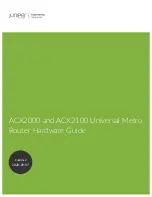
Chapter 23: LLDP
318
Overview
The data sent and received by LLDP are useful for many reasons. The
switch can discover other devices directly connected to it. Neighboring
devices can use LLDP to advertise some parts of their Layer 2
configuration to each other, which may highlight inconsistencies in the
neighboring device’s configuration which can then be corrected.
LLDP is a “one-hop” protocol. LLDP information can only be sent to and
received by devices that are directly connected to each other, or
connected via a hub or repeater. Devices that are directly connected to
each other are called neighbors. Advertised information is not forwarded
on to other devices on the network. Also, LLDP is a one-way protocol.
That is, the information transmitted in LLDP advertisements flows in one
direction only, from one device to its neighbors, and the communication
ends there. Transmitted advertisements do not solicit responses, and
received advertisements do not solicit acknowledgements. LLDP cannot
solicit any information from other devices. LLDP operates over physical
ports only. For example, it can be configured on switch ports that belong to
static port trunks or LACP trunks, but not on the trunks themselves, and on
switch ports that belong to VLANs, but not on the VLANs themselves.
Each port can be configured to transmit local information, receive neighbor
information, or both. LLDP transmits information as packets called LLDP
Data Units (LLDPDUs). An LLDPDU consists of a set of Type-Length-
Value elements (TLV), each of which contains a particular type of
information about the device or port transmitting it.
Summary of Contents for AT-GS950/48
Page 10: ...Contents 10...
Page 14: ...Figures 14...
Page 16: ...List of Tables 16...
Page 20: ...Preface 20...
Page 22: ...22...
Page 62: ...Chapter 2 System Configuration 62...
Page 64: ...64...
Page 108: ...Chapter 6 Static Port Trunking 108...
Page 124: ...Chapter 8 Port Mirroring 124...
Page 186: ...Chapter 13 Virtual LANs 186...
Page 194: ...Chapter 14 GVRP 194...
Page 210: ...210...
Page 224: ...Chapter 16 SNMPv1 and v2c 224...
Page 242: ...Chapter 17 SNMPv3 242...
Page 258: ...Chapter 18 Access Control Configuration 258...
Page 272: ...Chapter 19 RMON 272...
Page 302: ...Chapter 21 Security 302...
Page 324: ...Chapter 23 LLDP 324...
Page 338: ...338...
Page 356: ...Chapter 27 LED ECO Mode 356...
Page 360: ...Chapter 28 Energy Efficient Ethernet 360...
Page 370: ...Chapter 29 Rebooting the AT GS950 48 370...
Page 392: ...Appendix A MSTP Overview 392...
















































